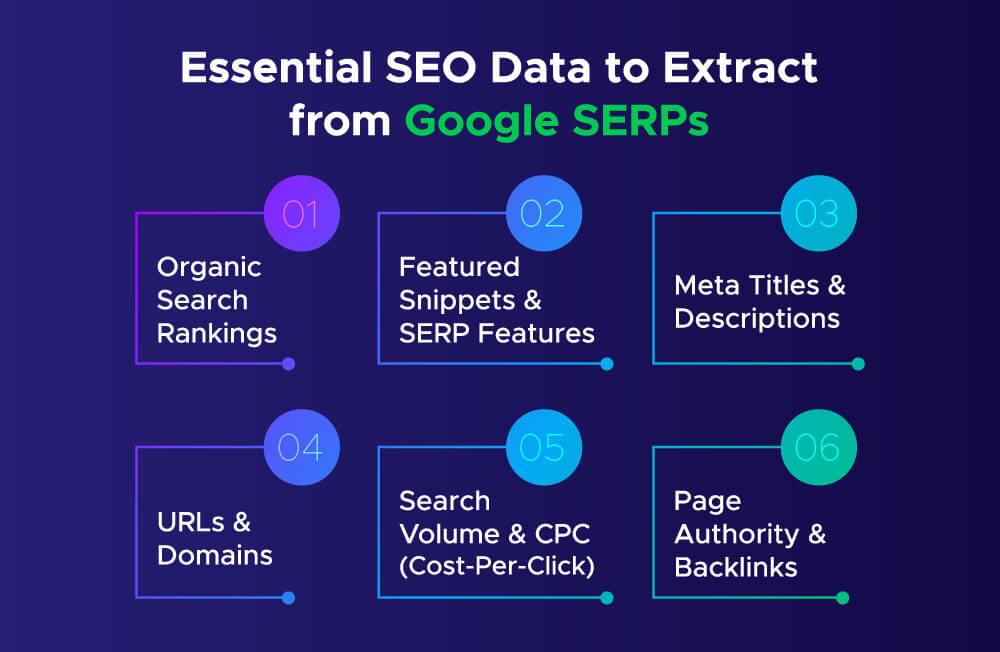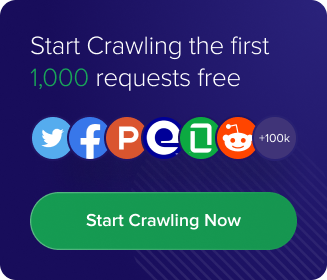Grabbing SEO data from Google search results is key to improving rankings, tracking competitors, and optimizing content. By scraping Google SERPs (Search Engine Results Pages), you can get valuable data like organic rankings, featured snippets, search volume, and keyword trends.
Google has anti-scraping measures in place, so scraping manually is impossible. Using the right tools and techniques ensures you can extract data efficiently without getting blocked.
In this guide, we’ll cover the data points to extract, the tools to use, and how to analyze search results using Python to make better decisions. Let’s start!
Table of Contents
- Essential SEO Data to Extract from Google SERPs
- Tools and Libraries to Use to Analyze Google SEO
- How to Scrape Google SERPs Efficiently
- Analyzing Extracted SEO Data
- Final Thoughts
- Frequently Asked Questions
Essential SEO Data to Extract from Google SERPs
Pulling the right SEO data from Google search results helps you improve rankings, track competitors, and refine your content strategy. Here are the data points to focus on:

1. Organic Search Rankings
Where does your website rank for specific keywords? Tracking ranking positions over time helps you measure SEO performance and spot trends.
2. Featured Snippets & SERP Features
Google shows featured snippets, knowledge panels, and “People Also Ask” sections. Extracting these helps you optimize for visibility.
3. Meta Titles & Descriptions
Meta titles and descriptions impact click-through rate (CTR). Extracting them from top-ranking pages helps you analyze trends and optimize your content.
4. URLs & Domains
Scraping URLs and domains of top-ranking pages helps you identify competitors and understand their SEO strategies.
5. Search Volume & CPC (Cost-Per-Click)
While search volume and CPC data aren’t directly available from SERPs, integrating data from keyword tools helps in keyword analysis and content planning.
6. Page Authority & Backlinks
Analyzing the ranking page’s authority and backlink profiles helps you understand why they rank higher and what you need to improve.
Extracting and analyzing these SEO metrics gives actionable insights to refine your strategy and outperform competitors. To get the best results, you can also outsource link building services to acquire quality backlinks.
Tools and Libraries to Use to Analyze Google SEO
To extract SEO data from Google search results efficiently, you need the right tools and libraries. Here are the tools and libraries for Python:
1. Crawlbase Crawling API
Google has anti-scraping measures, but Crawlbase Crawling API bypasses CAPTCHA, renders JavaScript, and gets search results without getting blocked.
2. BeautifulSoup
It parses and extracts structured data from the HTML content retrieved through the Crawlbase API.
3. Pandas
It stores and organizes extracted SEO data into structured formats like CSV or DataFrames for easy analysis.
4. Keyword Research Tools
Google Keyword Planner, Ahrefs, or SEMrush complement the scraped data by providing search volume, keyword difficulty, and CPC.
5. Data Visualization Tools
Matplotlib & Seaborn helps to visualize keyword trends, ranking changes and competitor analysis.
By using Crawlbase Crawling API along with these tools, you can collect and analyze SEO data to improve your search rankings.
How to Scrape Google SERPs Efficiently
Scraping Google search results requires a strategy to avoid detection and get accurate SEO data. Instead of building a scraper from scratch, we recommend using Crawlbase Crawling API, which handles JavaScript rendering, CAPTCHA solving, and IP rotation for you.
To learn how to scrape Google SERPs, follow the step-by-step guide in our blog:
🔗 Scrape Google Search Results with Python
This guide covers:
✅ Setting up Crawlbase Crawling API
✅ Getting search rankings, titles, meta descriptions and URLs
✅ Handling pagination and avoiding Google’s anti-bot measures
With the right tools and knowledge, you can collect SEO data for analysis without getting blocked.
Analyzing Extracted SEO Data
Once you have scraped Google search results, now its time to analyze the data for SEO insights. Here’s how:
1. Understanding Search Rankings
- Get top-ranking pages for your target keywords.
- Compare titles and meta descriptions of top-ranking competitors.
2. Competitor Analysis
- Check the URLs and domains appearing in the top results.
- Find out which competitors dominate the SERPs for your niche.
3. Keyword Optimization
- Analyze related searches from the Google SERP response.
- Identify long-tail keywords and user search intent.
4. Featured Snippets & People Also Ask (PAA)
- If Google’s “People Also Ask” (PAA) section shows up, extract questions related to your keyword.
- Use these questions to optimize content and improve search visibility.
5. Link Opportunities
- Extract links from top-ranking pages for backlink opportunities.
- Monitor ads and sponsored links to see which brands are investing in paid search.
Using Pandas for Data Analysis
You can store the extracted data in a CSV file for further analysis. Here’s how you can load and analyze it using Pandas:
1 | import pandas as pd |
Use this SEO data to fine-tune your content, track rankings, and stay ahead of the competition in Google.
Final Thoughts
Extracting SEO data from Google is crucial to improving search rankings and beating the competition. By using structured data, finding top-ranking pages, and analyzing related searches, you can fine-tune your SEO.
Scraping Google SERPs with Crawlbase Crawling API and combining them with tools like Pandas will uncover keyword trends, competitor insights, and backlink opportunities.
A data-driven approach to SEO means better decision-making and higher search visibility. Start extracting and analyzing SEO data today and boost your rankings and online presence.
Frequently Asked Questions
Q. What SEO data can be extracted from Google search results?
You can pull organic search rankings, meta titles, descriptions, URLs, featured snippets, related searches, and People Also Ask (PAA) questions. This is good for keyword research, competitor analysis, and content optimization.
Q. How can I scrape Google search results without getting blocked?
To scrape Google safely, use techniques like rotating proxies, setting user agents, adding delays between requests, and using tools like Crawlbase Crawling API, which handles CAPTCHA solving and JavaScript rendering to avoid detection.
Q. What are the best tools for extracting and analyzing SEO data?
The best tools to extract and analyze SEO data are Crawlbase Crawling API for scraping, BeautifulSoup and Pandas for parsing and analyzing data, and Google Sheets or Excel for organizing insights. This makes SEO data collection easy and actionable.










